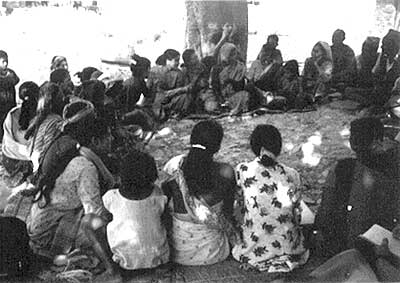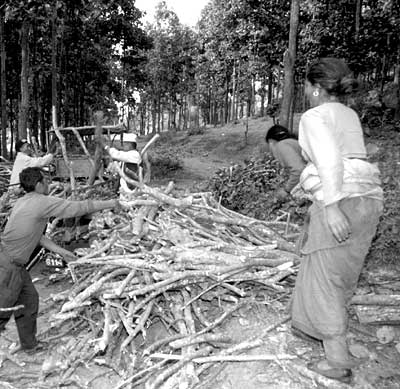|
Incorporating gender into a male domain:
the approach of a
forestry project in Nepal1
J.D. Gurung
and K. Lama
Jeannette Denholm Gurung and Kanchan Lama work with the global
network organization Women Organising for Change in Agriculture and Natural Resource Management. They are based in Vientiane, Lao People's Democratic Republic, and Kathmandu, Nepal, respectively.
A strategy for changing attitudes and behaviour to integrate concepts of gender equality into the institutional culture of forestry organizations.

An HLFFDP group meeting facilitated by
a group promoter
Forestry has traditionally been a predominantly masculine profession in most countries. Today almost all development projects supported by international donor agencies include a gender component. Yet very few include, as an objective, changing the attitudes and behaviour of the implementing organizations so they will promote gender equality themselves. The Hills Leasehold Forestry and Forage Development Project (HLFFDP) in Nepal demonstrates a successful strategy for changing the attitudes of rural people and, more significantly, forestry professionals.
HLFFDP, implemented by FAO, was initiated in 1993 by the Government of Nepal and the International Fund for Agricultural Development (IFAD) to raise the income of families below the poverty line and improve ecological conditions. The project entailed leasing areas of degraded forest land to groups of poor households, who would be assisted to regenerate the land. The project received specific funding from the Netherlands Development Assistance (NEDA) to include a gender mainstreaming component with a view to promoting the participation of women.
Like most forestry departments around the world, Nepal's Department of Forests was permeated by hierarchical and masculine values, which also reflect the values of Nepali society. In Nepal, because of women's social training, lack of control over productive resources and low levels of literacy, their relation to the professional world and the development process is largely mediated by men. To achieve the participation and the empowerment of rural, uneducated women, an attitudinal change was needed regarding women and their capabilities.
Leadership training for local women
Under the strategy of HLFFDP, a cadre of local female group promoters was recruited from around the country and trained to mobilize women's participation. Their role was to visit leasehold groups, facilitate monthly meetings and oversee group activities and finances, helping the groups learn to take over these tasks in time. They also served as contact persons between district service agencies and the leasehold groups, facilitating the groups' access to resources for education, health, cottage industry, irrigation, etc.
The female group promoters - who mostly had little or no formal education and were often from socially discriminated castes or ethnic groups - were trained by an all-women gender team, which provided continual gender and leadership training and backup support at field level by holding village meetings with them every month and counselling their husbands and other family members. The training methods included games, storytelling, drawing pictures, singing, dancing and, most effectively, role playing and speechmaking.
The gender team also introduced the female group promoters to all the important line agencies at the district level and gave them practical training in how to deal with district forestry officers, district livestock officers and bankers. The gender team members were highly experienced women from an NGO background. They always involved male staff, especially government officials and extension staff, in their working team as resource persons, role models and district gender focal persons.
Changes in attitudes at the local level
The training provided to the female group promoters helped develop their confidence and leadership abilities; they developed a strong sense of mission and a willingness to take risks and to speak out.
The group promoters brought about changes in attitudes and behaviour among the men and women of the leasehold groups, starting with the members of their own families and later holding gender sensitization training sessions with the members of their groups (men and women). As a result, women chairpersons were elected in a few leasehold groups, and it became common for women to take the lead along with men in group meetings and forestry planning. By 2001, the participation of women in all HLFFDP training and study tours had increased by 50 percent. The all-women leasehold groups (224 of 1 652 or 13.6 percent of all groups in 2001) were considered among the most active of the groups.
By publishing stories and poetry about leasehold forestry, the importance of women's participation, success stories and problems, and good and objectionable treatment received from forest staff, the women group promoters also spread their message at the district and national levels, helping to change the attitudes of various government officials. The group promoters' newly developed confidence helped them to obtain a respectable position not only in their own communities, but also among government officials. They were able to secure services such as literacy classes even from agencies not involved directly in the project.
Enhanced gender awareness in the Department of Forests
Initially, there was some resistance among some of the Department of Forests staff to what they saw as an irrelevant initiative pushed by project donors. Many of the staff did not believe that women had knowledge or skills that could be useful to the project. They questioned the ability of women to walk in difficult terrain, to work after marriage and childbirth, and to speak properly with government staff.
Training staff in the Department of Forests and other line agencies - mostly male mid-level foresters, agriculturists and livestock technicians - were trained by the gender team to serve as gender focal persons. They were trained to integrate women in departmental training and to include a session on gender analysis in all their regular training sessions. The gender focal persons also promoted mutual respect among the male and female staff of their own offices. Altogether 32 men and four women - including also ten bank managers and two staff members from the National Agricultural Resarch Council - were trained as gender focal persons to serve as agents of change in their own organizations.
Previously the District Forest Officers had excluded the women group promoters from regular staff meetings on HLFFDP matters. After the gender interventions, the women group promoters became major contributors in all HLFFDP-related meetings and influenced HLFFDP district-level planning and programming. This acceptance of rural, barely literate women in district-level government planning meetings was unprecedented.
Continuity of change
Perpetuating the gains that have been achieved will depend on sustainable, long-term policies and organizational commitments to gender mainstreaming. Leadership and structures for promoting gender equality need to be built into forestry institutions, to provide room for advocacy by rural women and their representatives. Modification of attitudes is also needed to allow other institutional changes - such as establishment of women's equality in inheritance rights to parental property.
Gender initiatives must not be viewed as concerns belonging exclusively to donors. If projects can demonstrate that women's empowerment can have positive impacts on forests and poverty, then government agencies may be moved to claim ownership of such initiatives, helping to move concern for women's empowerment from the field to the central level. The Nepal case may serve as an example: although the advances made by the leasehold groups cannot be credited to the gender component alone, where the women group promoters worked, the sense of responsibility and sustainability was noteworthy.
A final point is that if women (or men) are illiterate or uneducated, it will be difficult for them to boost their role in the forestry profession. Education for women is a keystone to establishing women's participation on equal ground with men.

Women participate actively in project activities such
as sale
of sustainably harvested fuelwood to support community improvement projects
1 This contribution is adapted from the paper “Incorporating gender into a male domain: a strategy for foresters?” presented at the XII World Forestry Congress (Quebec City, Canada, 21-28 September 2003) and published in the congress proceedings. | 

